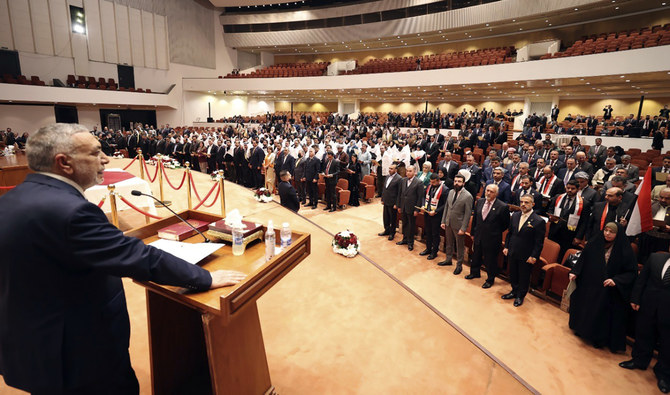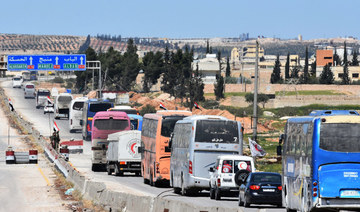BAGHDAD: Three tense months after legislative elections, Iraq’s parliament has finally held its inaugural session — but opening debates swiftly descended into furious arguments between
Shiite factions.
In multi-confessional and multi-ethnic Iraq, the formation of governments has involved complex negotiations ever since the 2003 US-led invasion toppled dictator Saddam Hussein.
Parliament only met for the first time since the October 10 vote on Sunday, after Iraq’s top court rejected a complaint of electoral irregularities filed by the Shiite and pro-Iran Hashd Al-Shaabi, a former paramilitary alliance.
Political analysts warn there are still several hard steps ahead before the formation of a new government.
Iraq is trying to emerge from almost two decades of conflict but is mired in corruption, economic crisis, with threats of violence lingering.
The newly elected members of parliament met for a swearing-in ceremony and to elect their speaker, but the debate soon turned ugly.
Videos filmed by MPs showing lawmakers becoming verbally aggressive with each other, highlighting divisions between Shiite groupings.
Iraq’s post-election period has been marred by high tensions, violence and allegations of vote fraud.
One of parliament’s first tasks must be to elect the country’s president, who will then name a prime minister tasked with forming a new government.
Shiite cleric Moqtada Sadr, who once led an anti-US militia and who opposes all foreign interference, has repeatedly said that the next prime minister will be chosen by his movement.
It won the largest share with 73 out of the assembly’s 329 seats, more than a fifth of the total.
But the Coordination Framework, including pro-Iran groups such as the Fatah (Conquest) Alliance, the political arm of the pro-Tehran Hashd Al-Shaabi, insist their coalition is bigger. The Coordination Framework claimed they can muster the backing of 88 lawmakers to make them the largest bloc.
That prompted fury from Sadr’s movement. In the ensuing chaos, MP Mahmud Al-Mashhadani, the oldest member of parliament who was therefore chairing the opening session, was taken ill.
One lawmaker alleged Mashhadani was “attacked,” state media said he fainted, and he was rushed to hospital where he was reportedly in a stable condition.
When the parliamentary session resumed an hour later, lawmakers reelected as speaker influential Sunni MP Mohammed Al-Halbussi of the Taqadom party.
Coordination Framework MPs boycotted the vote.
No single party holds an outright majority, so the next leader will be voted in by whichever coalition can negotiate allies to become the biggest bloc.
In previous parliaments, parties from Iraq’s Shiite majority have struck compromise deals to work together and form a government.
But Sadr has hinted he prefers an alliance with Sunni groups including Taqadom as well as the Kurdistan Democratic Party.
“In theory, they could push through and have their president elected and their prime minister designated,” said political scientist Hamza Haddad.
One leader in the Shiite Coordination Framework, speaking on condition of anonymity, admitted that if Sadr presses ahead with a coalition including Sunni parties and the KDP, they will be able to choose the government.
However, if Sadr works with Shiite parties as in past parliaments, then the Coordination Framework “will have the upper hand,” the leader added.
If the Coordination Framework had a choice, a leading contender would be ex-prime minister Nuri Al-Maliki, a figure close to Iran whose own group won 33 seats.
Maliki would be unthinkable for Sadrists.
They, however, have not put forward any name to replace current Prime Minister Mustafa Al-Kadhimi, who has not clearly said whether he wants to remain in power.
Al-Khadimi, a former intelligence chief, is Shiite like all his predecessors. He was confirmed in the last parliament by a coalition of Shiite-majority lawmakers.
“As long as the two Shiite sides remain divided, that could lead to more violence,” the political analyst Haddad said.
There has already been unrest following the election.
Al-Kadhimi escaped unhurt when an explosive-packed drone hit the prime minister’s residence in November during what his office called an “assassination attempt.”
No group has claimed the attack.
“It is difficult to see either side quietly allowing the other to lead a government formation without the other,” Haddad added, noting that both Sadr and the Conquest Alliance have armed backers.
“The biggest fear would be fighting,” he said.






















